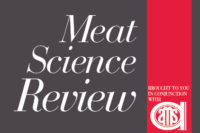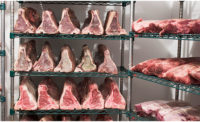Meat Science Review
Does feeding RFMDGS decrease beef quality?
The effects of reduced-fat modified distillers grains with solubles (RFMDGS) in finishing diets of feedlot steers on fresh and processed beef quality.

The 2013 corn ethanol industry expansion introduced a new livestock feed: reduced-fat distillers grains which contains 3 percent less ether extract, 6 to 9 percent less corn oil, and similar energy values compared to full-fat distillers grains1,2,4. Of the fat within distillers grains, 49 percent is linoleic fatty acid which has been shown to decrease retail shelf life stability through oxidation resulting in faster onset of rancidity and decreasing consumer appeal3,5,6.
An objective of the present study was to quantify the effects of varying levels of reduced-fat modified distillers grains with solubles (RFMDGS) on carcass characteristics and fresh and processed meat quality.
Our study utilized fifty crossbred (Angus x Gelbvieh X Holstein x Jersey) steers (initial body weight: 379 ± 32 kg) that were randomly assigned to one of four dietary treatments that consisted of: 14.93 percent RFMDGS of diet dry matter (DMD) with 0.74 percent corn oil DMD (FF15); 15.60 percent RFMDGS DMD (RF15); 30.84 percent RFMDGS DMD (RF30); and 46.27 percent RFMDGS DMD (RF45). Diet FF15 mimicked a full-fat distillers grains diet and served as the control. Steers were fed dietary treatments for 181 days and then fed a common diet for four days before harvesting.
Hot carcass weight (HCW), 12th rib backfat (BF); ribeye area (REA); percent kidney, pelvic, and heart fat (KPH); and marbling score data were collected 24 hours postmortem. Strip loins (IMPS #180) were collected for vacuum purge loss evaluation and fabricated into 2.54 cm steaks for drip loss, cook loss and sensory evaluation (n = 122; untrained panelists; 120-point labeled affective magnitude scales). Shoulder clods (IMPS #114) were used to create ground beef and bologna. Blended meat blocks were utilized to make an emulsified bologna product using a commercial seasoning blend. Thiobarbituric acid reactive substances (TBARS) analysis occurred utilizing d0 and d14 retail shelf life ground beef samples that were vacuum sealed and frozen until analysis. Bologna samples were evaluated for sensory attributes (n = 108; untrained panelists; 120- point labeled affective magnitude scales). Twelfth rib backfat was analyzed for fatty acid composition and calculated iodine value. All data was analyzed using PROC MIXED procedure in SAS.
There was no treatment effect for HCW (P = 0.96), BF (P = 0.63), REA (P = 0.62), KPH (P = 0.27) or marbling score (P = 0.67). All moisture loss attributes did not differ among treatments (P = 0.09). There was no treatment effect for overall liking (P = 0.15), flavor liking (P = 0.75), texture liking (P = 0.07) or off-flavor (P = 0.72) in steak sensory analysis. Subjective toughness values of steaks from FF15 were greater than RF15 (10.78 and 8.77, respectively; P = 0.01). Subjective juiciness values of steaks from FF15 were greater than RF45 (8.50 and 6.94, respectively;
P = 0.03). There was no treatment effect for flavor liking or off-flavor in bologna sensory analysis. Subjective overall liking was greater in RF45 compared to FF15 bologna samples (78.14 and 71.63, respectively; P = 0.03). Subjective texture liking of bologna from RF45 were greater than FF15 (78.25 and 67.51, respectively; P <0.01). Subjective toughness liking of bologna from RF30 and RF45 were greater compared to FF15 (77.21, 78.25, and 67.51, respectively; P <0.01). There was no treatment effect for d0 or d14 TBARS (P = 0.94 and P = 0.27, respectively). Treatment did not affect percentage of linoleic acid (C18:n-6, P = 0.34) or calculated iodine value (P = 0.59).
Although results indicate feeding 45 percent RFMDGS had no effect on carcass characteristics, it altered subjective fresh beef quality, increased subjective processed beef quality, and had minimal effects on fatty acid composition when compared to the mimicked full-fat diet. NP
References:
- Anderson, Vern and Chanda Engel. 2014. Effects of Fat Level in Distillers Grain on Feedlot Finishing Performance and Carcass Traits. Available at: https://www.ag.ndsu.edu/carringtonrec/documents/livestockrd/docs2014/2014-effects-of-fat-level-in-distillers-grain-on-feedlot-finishing-performance-and-carcass-traits. Accessed on March 20, 2016.
- Buckner, C. D., G. E. Erickson, T. L. Mader, S. L. Colgan, K. K. Karges, and M. L. Gibson. 2007. Optimum Levels of Dry Distillers Grains with Solubles for Finishing Beef Steers. Nebraska Beef Cattle Report. MP90:36-38.
- Diaz-Royon, Fernando; Garcia, Alvaro; and Kurt A. Rosentrater. 2012. Composition of Fat in Distillers Grains. iGrow.
- Lundy, E. L. and D. Loy. 2014. Ethanol Coproducts for Beef Cattle: The Changing Distillers Grains for Feedlot Cattle. Iowa Beef Center. Iowa State University Extension and Outreach Factsheet.
- McClements, D. J. and E. A. Decker. 2008. Lipids. In S. Damodaran, K. L. Parkin, and O. R. Fennema (eds), Fennema’s food chemistry. 4th ed. CRC Press, Boca Raton, Fla.
- Wood, J.D.; Richardson, R.I.; Nute, G.R.; Fisher, A.V.; Campo, M.M.; Kasapidou, E.; Sheard, P.R.; and M. Enser. 2003. Effects of fatty acids on meat quality: a review. Meat Sci. 66:21-32.
Looking for a reprint of this article?
From high-res PDFs to custom plaques, order your copy today!





